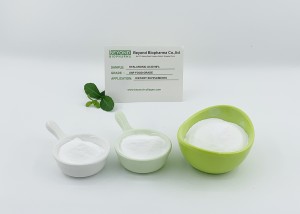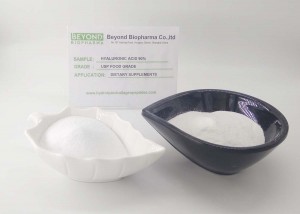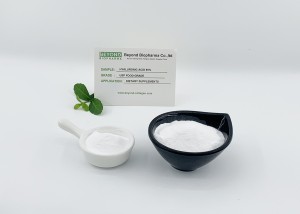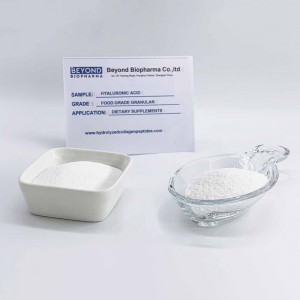กรดไฮยาลูโรนิกเกรดอาหารที่ปลอดภัยถูกสกัดโดยการหมัก
| ชื่อวัสดุ | เกรดอาหารของกรดไฮยาลูโรนิก |
| ต้นกำเนิดของวัสดุ | ต้นกำเนิดของการหมัก |
| สีและรูปลักษณ์ | ผงสีขาว |
| มาตรฐานคุณภาพ | ในบ้านมาตรฐาน |
| ความบริสุทธิ์ของวัสดุ | >95% |
| ความชื้น | ≤10% (105° เป็นเวลา 2 ชั่วโมง) |
| น้ำหนักโมเลกุล | ประมาณ 1,000,000 ดาลตัน |
| ความหนาแน่นเป็นกลุ่ม | >0.25g/ml เป็นความหนาแน่นรวม |
| ความสามารถในการละลาย | ละลายน้ำได้ |
| แอปพลิเคชัน | เพื่อสุขภาพผิวหนังและข้อต่อ |
| อายุการเก็บรักษา | 2 ปีนับจากวันผลิต |
| การบรรจุ | บรรจุภายใน: ถุงฟอยล์ปิดผนึก, 1 กก. / ถุง, 5 กก. / ถุง |
| บรรจุด้านนอก: 10 กก./ไฟเบอร์กลอง, 27 กลอง/พาเลท |
กรดไฮยาลูโรนิกiเป็นเมือกโพลีแซ็กคาไรด์ที่เป็นกรด ซึ่งเป็นไกลโคไกลโคไกลโคซามิโนไกลแคนตัวเดียวที่ประกอบด้วยกรด D-กลูโคโรนิก และ N-อะซิติลกลูโคซามีนกรดไฮยาลูโรนิกแสดงการทำงานทางสรีรวิทยาที่สำคัญมากมายในร่างกายด้วยโครงสร้างโมเลกุลที่เป็นเอกลักษณ์และคุณสมบัติทางเคมีกายภาพ
กรดไฮยาลูโรนิกพบกันอย่างแพร่หลายในเมทริกซ์นอกเซลล์ของเนื้อเยื่อเกี่ยวพันของสัตว์ เช่น สายสะดือของมนุษย์ หงอนไก่ และแก้วตาวัวโมเลกุลประกอบด้วยหมู่คาร์บอกซิลและไฮดรอกซิลจำนวนมาก สามารถดูดซับน้ำได้มาก เป็นองค์ประกอบสำคัญของการให้ความชุ่มชื้นแก่ผิวในเวลาเดียวกัน กรดไฮยาลูโรนิกยังมีความหนืดสูง มีผลทำให้ข้อต่อและน้ำเลี้ยงตาเปียกและป้องกันได้ และสามารถส่งเสริมการสมานแผลได้
กรดไฮยาลูโรนิกมีการใช้งานที่หลากหลายในวงการแพทย์ ใช้ในการรักษาโรคข้ออักเสบ การผ่าตัดตา และส่งเสริมการรักษาบาดแผลในอุตสาหกรรมเครื่องสำอาง กรดไฮยาลูโรนิกถูกนำมาใช้กันอย่างแพร่หลายในผลิตภัณฑ์ดูแลผิวทุกประเภท เนื่องจากมีฟังก์ชั่นให้ความชุ่มชื้นที่เป็นเอกลักษณ์ ซึ่งสามารถปรับปรุงผิวแห้งได้อย่างมีประสิทธิภาพ ลดริ้วรอย และทำให้ผิวเรียบเนียน ละเอียดอ่อน และยืดหยุ่นมากขึ้น
นอกจากนี้ กรดไฮยาลูโรนิกยังแบ่งออกเป็นโมเลกุลขนาดใหญ่ โมเลกุลขนาดกลาง โมเลกุลขนาดเล็ก และโมเลกุลต่ำมากประเภทต่างๆ ตามขนาดน้ำหนักโมเลกุล เพื่อตอบสนองความต้องการของสถานการณ์การใช้งานที่แตกต่างกันการไฮโดรไลซิสของกรดไฮยาลูโรนิกในฐานะโมเลกุลของกรดไฮยาลูโรนิกที่มีระดับการเกิดพอลิเมอไรเซชันต่ำมาก ยังถูกนำมาใช้กันอย่างแพร่หลายในบางสาขาเนื่องจากมีคุณสมบัติเฉพาะตัว
| รายการทดสอบ | ข้อมูลจำเพาะ | ผลการทดสอบ |
| รูปร่าง | ผงสีขาว | ผงสีขาว |
| กรดกลูโคโรนิก, % | ≥44.0 | 46.43 |
| โซเดียมไฮยาลูโรเนต, % | ≥91.0% | 95.97% |
| ความโปร่งใส (สารละลายน้ำ 0.5%) | ≥99.0 | 100% |
| pH (สารละลายน้ำ 0.5%) | 6.8-8.0 | 6.69% |
| การจำกัดความหนืด dl/g | ค่าที่วัดได้ | 16.69 |
| น้ำหนักโมเลกุล, ดา | ค่าที่วัดได้ | 0.96X106 |
| ขาดทุนจากการอบแห้ง % | ≤10.0 | 7.81 |
| สารตกค้างจากการจุดระเบิด, % | ≤13% | 12.80 |
| โลหะหนัก (เป็น pb), ppm | ≤10 | <10 |
| ตะกั่ว มก./กก | <0.5 มก./กก | <0.5 มก./กก |
| สารหนู มก./กก | <0.3 มก./กก | <0.3 มก./กก |
| จำนวนแบคทีเรีย, cfu/g | <100 | เป็นไปตามมาตรฐาน |
| ราและยีสต์, cfu/g | <100 | เป็นไปตามมาตรฐาน |
| สแตฟิโลคอคคัส ออเรียส | เชิงลบ | เชิงลบ |
| Pseudomonas aeruginosa | เชิงลบ | เชิงลบ |
| บทสรุป | ได้มาตรฐาน | |
1. ผลความชุ่มชื้น: กรดไฮยาลูโรนิกมีความสามารถในการให้ความชุ่มชื้นที่แข็งแกร่ง ซึ่งช่วยรักษาความชุ่มชื้นของผิว เพื่อปรับปรุงสภาพผิว และทำให้ผิวเรียบเนียนและยืดหยุ่นมากขึ้น
2. การหล่อลื่นข้อต่อ: กรดไฮยาลูโรนิกสามารถหล่อลื่นข้อต่อ ปรับปรุงการทำงานของข้อต่อ ลดการสึกหรอของข้อต่อ และมีผลในการดูแลสุขภาพสำหรับผู้ป่วยที่เป็นโรคข้อต่อ
3. ปรับปรุงสุขภาพตา: กรดไฮยาลูโรนิกสามารถเพิ่มปริมาณน้ำในเยื่อบุตา ช่วยปรับปรุงอาการตาแห้ง รู้สึกไม่สบาย และปัญหาอื่น ๆ และปกป้องสุขภาพตา
4. สารต้านอนุมูลอิสระและการซ่อมแซม: กรดไฮยาลูโรนิกยังมีฤทธิ์ต้านอนุมูลอิสระในร่างกาย ซึ่งสามารถช่วยกำจัดอนุมูลอิสระ ลดการตอบสนองต่อความเครียดจากปฏิกิริยาออกซิเดชั่น และยังช่วยซ่อมแซมเยื่อบุกระเพาะอาหารและเนื้อเยื่ออื่น ๆ ที่เสียหายอีกด้วย
1. การหล่อลื่น: กรดไฮยาลูโรนิกเป็นส่วนประกอบหลักของของเหลวในไขข้อและของเหลวในไขข้อเป็นวัสดุพื้นฐานในการรักษาการทำงานของข้อต่อเมื่อข้อต่อเคลื่อนไหวช้าๆ (เช่น การเดินปกติ) กรดไฮยาลูโรนิกจะทำหน้าที่เป็นสารหล่อลื่นเป็นหลัก ซึ่งช่วยลดแรงเสียดทานระหว่างเนื้อเยื่อข้อต่อได้อย่างมาก ปกป้องกระดูกอ่อนข้อต่อ และลดความเสี่ยงของการสึกหรอของข้อต่อ
2. การดูดซับแรงกระแทกแบบยืดหยุ่น: เมื่อข้อต่ออยู่ในสภาวะที่มีการเคลื่อนไหวอย่างรวดเร็ว (เช่นการวิ่งหรือการกระโดด) กรดไฮยาลูโรนิกจะมีบทบาทเป็นโช้คอัพแบบยืดหยุ่นเป็นหลักสามารถรองรับการกระแทกของข้อต่อ ลดแรงกระแทกของข้อต่อ จึงลดความเสี่ยงของการบาดเจ็บที่ข้อต่อ
3. การจัดหาสารอาหาร: ไฮยาลูโรแนนยังช่วยจัดหาสารอาหารที่จำเป็นให้กับกระดูกอ่อนข้อและรักษาการทำงานที่ดีต่อสุขภาพและเป็นปกติของกระดูกอ่อนข้อในเวลาเดียวกัน ยังสามารถส่งเสริมการปล่อยของเสียในข้อต่อ เพื่อรักษาสภาพแวดล้อมของข้อต่อให้สะอาดและมั่นคง
4. การส่งสัญญาณของเซลล์: ไฮยาลูโรแนนยังมีหน้าที่ส่งสัญญาณเซลล์ในข้อต่อ มีส่วนร่วมในการสื่อสารและการควบคุมเซลล์ภายในข้อต่อ และมีความสำคัญอย่างยิ่งต่อการรักษาการทำงานทางสรีรวิทยาตามปกติและความสมบูรณ์ของโครงสร้างของข้อต่อ
1. การดูแลดวงตา: กรดไฮยาลูโรนิกใช้แทนน้ำเลี้ยงตาในการผ่าตัดตา เพื่อรักษารูปร่างของดวงตาและเอฟเฟกต์การมองเห็นนอกจากนี้ยังสามารถนำมาใช้ทำยาหยอดตาเพื่อบรรเทาอาการตาแห้งและไม่สบายตา และช่วยหล่อลื่นดวงตาได้อีกด้วย
2. การบำบัดบาดแผล: กรดไฮยาลูโรนิกสามารถปรับปรุงความชุ่มชื้นของเนื้อเยื่อและเพิ่มความต้านทานต่อความเสียหายทางกล ดังนั้นจึงมีบทบาทสำคัญในกระบวนการสมานแผลสามารถใช้กับผ้าปิดแผลหรือขี้ผึ้งเพื่อช่วยให้แผลหายเร็วขึ้นและสมบูรณ์ยิ่งขึ้น
3. ผลิตภัณฑ์ดูแลผิว: กรดไฮยาลูโรนิกสามารถเติมเป็นมอยเจอร์ไรเซอร์และมอยเจอร์ไรเซอร์ให้กับผลิตภัณฑ์ดูแลผิวหลากหลายชนิด เช่นครีมทาหน้า เอสเซนส์ อิมัลชั่น ฯลฯ ความสามารถในการให้ความชุ่มชื้นอันทรงพลังช่วยรักษาสมดุลความชุ่มชื้นของผิว ปรับปรุง เนื้อสัมผัสและทำให้ผิวเรียบเนียนขึ้น
4. การดูแลช่องปาก: กรดไฮยาลูโรนิกสามารถนำมาใช้ในผลิตภัณฑ์สุขภาพช่องปากได้ เช่น สเปรย์สำหรับช่องปาก ยาสีฟัน ฯลฯ เพื่อให้การหล่อลื่นในช่องปากและความสบาย และช่วยบรรเทาอาการไม่สบายที่เกิดจากแผลในช่องปากหรือการอักเสบในช่องปาก
5. อาหารและเครื่องดื่ม: นอกจากนี้ กรดไฮยาลูโรนิกยังถูกเติมลงในอาหารและเครื่องดื่มบางชนิด เพื่อเป็นสารเพิ่มความหนาตามธรรมชาติและมอยเจอร์ไรเซอร์เพื่อปรับปรุงรสชาติและเนื้อสัมผัสของผลิตภัณฑ์
6. วัสดุชีวภาพ: เนื่องจากความเข้ากันได้ทางชีวภาพและความสามารถในการย่อยสลาย กรดไฮยาลูโรนิกจึงถูกใช้เป็นวัตถุดิบสำหรับวัสดุชีวภาพ เช่น โครงสร้างวิศวกรรมเนื้อเยื่อ ตัวพายา เป็นต้น
เมื่อแปรรูปผงกรดไฮยาลูโรนิก จะสามารถเปลี่ยนเป็นรูปแบบสำเร็จรูปที่แตกต่างกันได้หลายรูปแบบ โดยแต่ละรูปแบบมีคุณสมบัติและการใช้งานเฉพาะตัวแบบฟอร์มสำเร็จรูปทั่วไปบางส่วนได้แก่:
1. เจลหรือครีมกรดไฮยาลูโรนิก: ผงกรดไฮยาลูโรนิกสามารถละลายในน้ำหรือตัวทำละลายอื่น ๆ เพื่อสร้างเจลหรือครีมที่มีความหนืดแบบฟอร์มนี้มักใช้ในผลิตภัณฑ์เครื่องสำอาง เช่น มอยเจอร์ไรเซอร์และครีมต่อต้านวัย เนื่องจากสามารถกักเก็บความชุ่มชื้นและเพิ่มความยืดหยุ่นของผิว
2. ฟิลเลอร์แบบฉีด: กรดไฮยาลูโรนิกสามารถนำมาแปรรูปเป็นฟิลเลอร์แบบฉีดที่ใช้ในขั้นตอนความงามได้โดยทั่วไปฟิลเลอร์เหล่านี้จะถูกผสมด้วยสารเพิ่มความคงตัวและสารเติมแต่งอื่นๆ เพื่อเพิ่มความทนทานและปลอดภัยในการฉีดเข้าสู่ผิวหนังใช้เพื่อทำให้ริ้วรอยเรียบเนียน เพิ่มรูปทรงใบหน้า และแก้ไขข้อบกพร่องด้านเครื่องสำอางอื่นๆ
3. อาหารเสริมในช่องปาก: ผงกรดไฮยาลูโรนิกสามารถกำหนดเป็นแคปซูลหรือยาเม็ดเป็นอาหารเสริมในช่องปากได้อาหารเสริมเหล่านี้มักวางตลาดเพื่อประโยชน์ที่เป็นไปได้ในการปรับปรุงสุขภาพข้อต่อ ความชุ่มชื้นของผิว และด้านอื่นๆ ของความเป็นอยู่โดยรวม
4. เซรั่มและโลชั่นเฉพาะที่: เช่นเดียวกับเจลและครีม ผงกรดไฮยาลูโรนิกสามารถรวมอยู่ในเซรั่มและโลชั่นเฉพาะที่ผลิตภัณฑ์เหล่านี้ใช้กับผิวหนังโดยตรงและได้รับการออกแบบมาเพื่อให้ความชุ่มชื้นและต่อต้านวัยของกรดไฮยาลูโรนิก
5. สารละลายของเหลว: ผงกรดไฮยาลูโรนิกสามารถละลายในสารละลายของเหลวสำหรับการใช้งานต่างๆ เช่น สารละลายทางตาสำหรับการหล่อลื่นดวงตา หรือเป็นส่วนประกอบในสารละลายชลประทานในการผ่าตัด
ฉันสามารถมีตัวอย่างเล็กๆ น้อยๆ เพื่อการทดสอบได้หรือไม่
1. จำนวนตัวอย่างฟรี: เราสามารถจัดหาตัวอย่างกรดไฮยาลูโรนิกฟรีได้สูงสุด 50 กรัมเพื่อการทดสอบกรุณาชำระค่าตัวอย่างถ้าคุณต้องการมากขึ้น
2. ค่าขนส่ง: เรามักจะส่งตัวอย่างผ่านทาง DHLหากคุณมีบัญชี DHL โปรดแจ้งให้เราทราบ เราจะส่งผ่านบัญชี DHL ของคุณ
วิธีการจัดส่งของคุณคืออะไร:
เราสามารถจัดส่งได้ทั้งทางอากาศและทางทะเล เรามีเอกสารการขนส่งที่ปลอดภัยที่จำเป็นสำหรับการขนส่งทั้งทางอากาศและทางทะเล
บรรจุภัณฑ์มาตรฐานของคุณคืออะไร?
บรรจุภัณฑ์มาตรฐานของเราคือ 1 กิโลกรัม/ถุงฟอยล์ และถุงฟอยล์ 10 ถุงใส่ลงในถังเดียวหรือเราสามารถบรรจุตามความต้องการของคุณได้











